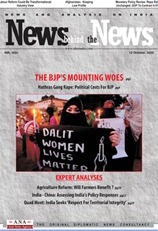Women’s safety in India is unattainable without change in mindset
Till such time that mothers, as well as families in India, don’t cease to feel a little less obsessed about that beloved male child, or they don’t bring an end to that entitled treatment showered on him more than he deserves, daughters of India will never be safe within the domestic boundaries or beyond, writes Anuja Saha for South Asia Monitor

“A woman must prefer her liberty over a man. To be happy, she must. A man to be happy, however, must yearn for his woman more than his liberty. This is the rightful order” - an excerpt from Hope and Despair by Roman Payne, novelist and poet.
Be it Delhi, Telangana, Unnao, Hathras, or Balrampur - the commonality of crime remains violence against women. While some of them were educated, urban, upper-caste women, others were Dalit. Being a casteist society that India is, oppression, brutality, and discrimination against the Dalits or the backward castes remains a historical truth. Contemplative of extensively insidious casteist mindsets, the atrocious sexual violence against the 19-year-old Dalit woman in Hathras, and the 22-year-old Dalit woman in Balrampur, both in India's most populous state of Uttar Pradesh, cannot be perceived as isolated episodes of crime; rather these atrocities appear as the upshot of organized, embedded, and deeply problematic issues of casteism and sexism.
Violence against women
Over the years, whether it was the Rameeza Bee rape case (1978), Manorama in Manipur (2004), the Nirbhaya case in Delhi (2012) or now in Hathras, these sexual offences against women exposes the reality of structural violence. It must be noted that in India, there are a range of intersections like identity, social structures and customs and traditions that lead to such systemic violence.
A Hathras or a Balrampur is mere names to identify the act of crime; however, the offence, violations, or indignity women face remains a recurring reality in India. The crucial question that looms large is what makes such cases of brutality and crime originate? Where does the impunity generate from that makes such incidences repeat time and again? What contribution does society make towards such criminal acts?
To have an answer to all these issues, one first needs to understand who women are. The general perception holds women to be homogenous, instead of considering them as a group of people who are impacted by differentiated factors of class, caste, race, religion, economy, ethnicity, etc. This generalization of a community becomes a fundamental setback to understand crimes meted out to women across the country.
According to the report of the National Crime Record Bureau (NCRB) for 2019, the rate of crime against women has increased by 7.3 percent compared to 2018. The report also shows that there has been a surge of 31 percent of reported rape cases in the country in the last 10 years, while each day India recorded 88 rape cases in 2019. As per the NCRB data for 2019, of the total reported rape cases, 11 percent belonged to the Dalit community; many times such cases of assault never get reported owing to the fear of sharp repercussion from ‘dominant’ read upper castes, men. Any form of sexual assault committed against Dalit women, hence, clearly reflects the psyche of dehumanizing the community and preserving hierarchies and power dynamics based on caste identities.
Gender inequality
The reactions to the Nirbhaya's case gave us a feeling that probably the mass has reached a tipping point and that both, the administration and individual, would make the country a better place for women to reside in. But the brutality of the Hathras incident underscored the fact that even eight years after the death of Nirbhaya (not her real name), which led to a national outcry and forced the government to bring in more stringent rape laws in India, nothing has changed.
The ‘monsters’ think they can escape abuse or murder and still equally desperate with their sense of indemnity continue to be as intact now as it were on that cold December night of 2012. The impunity that these men indulge in beastly cruelty emanates from society – societal normative, social discrimination, and gender inequality.
As we say that family is the basic unit of society, asymmetrical practices within the family mark the first rot in the system. Preference for a male child leading to a heinous crime of female foeticide with a false sense of righteousness is still prevalent in India. This bias further continues when the male child receives preferential treatment in terms of the basic choices of food or clothes and even in education or life choices.
Most Indian men have been brought up by the societal normativity to be a symbol of privileged gender. The society that organically does not speak loud and clear about gender equality usually entrusts the mother with the duty of providing privileges and preferences to the male child and hence this child grows up in an environment where a female ‘submits’ to all demands of the male. This conditioning makes the child expect and believe that his partner, girlfriend, wife, or even a random female would give in to his whims and fancies. Otherwise, ‘treating a lesson’ is a familiar resort. The official data by NCRB states that in 2019 there were 30.9 percent cases reported under the Indian Penal Code (IPC) for brutality by a husband or his family.
Rape and sexual offences being the outcome of systemic violence in the society, it surfaces in our everyday life and practices as on television or movies any form of female harassment by the hero is displayed as virility. Indian movies have the mandate to entertain the masses and many do so by depicting physical violence towards the female partner by the hero in the name of 'showcasing the love in a relationship.’
It reflects a deep rot in the social outlook and one can understand what that crisis means when such a movie is celebrated to be a blockbuster.
In a regular Indian household commonly mother conditions her son with the idea of ‘boys don’t cry’; the society for years has indulged hypermasculinity in this form or other. In an over-crowded vehicle when a female co-passenger jostles vulnerably for a grip at an arm’s length, the putrefied mindset perceives that woman more as ‘easy prey’ instead of a fellow traveler.
Change in male mindset
Over seven decades of independence have made India reach Mars and the moon, achieve extraordinarily technological pursuit or set goals to become a five trillion dollar economy, but what has not changed or turned better is the condition of women in this country.
The issue of women’s safety or preventing violence against women now does not only pertain to legislation or legal strictures. The profusion of physical and mental assault against women has become an endemic of the sociological flaw and psychological trouble. The incident in Hathras has not only exposed how unsafe women are in their own village or country but also revealed an entrenched feudal mentality bordering on animalistic propensities.
Till such time that mothers, as well as families in India, don’t cease to feel a little less obsessed about that beloved male child, or they don’t bring an end to that entitled treatment showered on him more than he deserves, daughters of India will never be safe within the domestic boundaries or beyond.
Generating a sense of fear and accountability is perhaps something that does not rest with the judiciary or by new legislation alone. The society at large is obligated to ensure that millions of adult males across the country cannot have the audacity to harass or misbehave with a female colleague, co-traveler, or even a friend.
(The writer is a doctoral student at the Department of International Relations, Jadavpur University, Kolkata. The views expressed are personal. She can be contacted at anujasaha.ju@gmail.com)
















Post a Comment